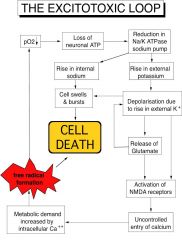![]()
![]()
![]()
Use LEFT and RIGHT arrow keys to navigate between flashcards;
Use UP and DOWN arrow keys to flip the card;
H to show hint;
A reads text to speech;
24 Cards in this Set
- Front
- Back
|
What is stroke? |
Stroke is the consequence of cerebrovascular disease that interrupts blood flow to part of the brain, causing ischaemia (inadequate blood flow) and hypoxia. 3rd most common disease in the UK after HD and cancer |
|
|
What are the 4 types of stroke? |
Thrombosis TIA Embolism Haemorrhage
n.b. occlusive strokes preserve consciousness |
|
|
What is cerebral thrombosis? |
Atherosclerosis induced clot -> degenerates vessel wall and causes platelet and fibrin accumulation. Distal circulation ceases. 60% in sleep - awake paralysed and unaware. Nocturnal onset hypotension. 20% stepwise - over several hours/days progressive neurological deterioration. |
|
|
What is a TIA? |
40% patients - temporary neurological deficit - disturbed neural function territory single artery. Deficit clears few minutes always within 24 hours. Quickly dissolves - may result in thrombotic stroke within hours/months. |
|
|
What is an embolic stroke? |
Foreign clot in cerebral artery. Neurological signs develop rapidly and do not progress. Always occurs during activity. Source is always always left side of heart. Causes - AF, MI - akinetic region of heart, defective/artificial heart valves esp mitral valves. |
|
|
What is a haemorrhagic stroke? |
Intracerebral haemhorrhage within sudden onset minutes to hours. Associated with severe headaches due to stretch of vessel before rupture. Consciousness not preserved -> stupor/coma progress with time. Cause - hypertensive, aneurysms, arteriovenous malformations |
|
|
What are risk factors for stroke? |
Hypertension 35-50% stroke risk BP reduction 10mmhg syst/5mmhg diast reduces risk 40% Hyperlipidaemia - statins reduce risk 15% Cigarette smoking Diabetes - 2/3x risk stroke, treatment not shown reduce risk Heart Disease AF - 5yr risk stroke - warfarin/aspirin |
|
|
Where does the MCA travel? |
Continuation ICA -> passes laterally between superior surface of anterior temporal lobe and inferior surface posterior lobe. |
|
|
What are the clinical significance of the lenticulostriate arteries? |
Branches from MCA at 90 degrees. Very prone to blockage and embolus. Supply the basal ganglia and internal all motor commands from motor cortex to BS and SC. |
|
|
What is the role of sodium pump in cerebral hypoxia? |
Keeps membrane potential and keeps cell size and shape. |
|
|
How is normal osmotic function of a cell maintained? |
DNA and internal proteins contribute to water IN Na has to be pumped out to balance osmotic pressure. All cells have sodium pumps. |
|
|
Why do sodium pumps have to work harder in neurones? |
Large surface area to volume, more sodium leakage, sodium in during action potential has to be pumped out. |
|
|
What is the normal extracellular space in the brain filled with? |
Extracellular fluid of about 20% allowing diffusion materials around and between cells. |
|
|
What happens to the neurones/glia in an impaired sodium/osmotic function? |
Swelling into rigid cranial cavity, decreases amount of extracellular space. Rise in ICP -> compressing cerebral veins -> loss blood flow and worsening hypoxia. |
|
|
What happens in severe cases of raised ICP? |
Brain herniates out of foramen magnum -> compression brainstem, coma, death |
|
|
How do you reduce the swelling and metabolic demands of brain cells? |
Cooling |
|
|
What happens to potassium in a hypoxic brain? |
Normally released from brain cell, uptaken via ATP pump. Extracellular K+ accumulates and deloparises adjacent cells -> neurotransmitter release. |
|
|
What happens to levels of synpatic neurotransmitter in stroke? |
Hypoxic brain cells cannot pump neurotransmitter back into nerve cells. Neurotransmitter released more (via potassium) and cannot be uptaken. |
|
|
What is the main excitatory neurotransmitter in the brain and what happens when this is in excess i.e. in stroke? |
Glutamate, acts on NMDA and AMPA receptor. Excess stimulation of NMDA after 3-5m anoxia -> excess Ca into cells. Fast/early excitotoxicity. Excess stimulation AMPA after several hours -> slow/delayed excitotoxicity |
|
|
What is a consequence of glutamate mediated calcium uptake in cerebral anoxia? |

Increased metabolic demand of the cell, formation of free radicals without oxygen for respiration. |
|
|
What is the penumbra region of a stroke focus? |
Possible survival region around inner 1/3rd of inevitable brain death Target treatment for stroke |
|
|
What is the blood flow treatment of targeting stroke? |
1. restoring blood flow - tPA - plasmin blocked by PAI-1 and a2-AP
|
|
|
What is the excitotoxicity treatment for targeting stroke? |
2. combat excitotoxicity - NMDA anatag Cerestat - block receptors therefore fast excitotox, successful serious SE, AMP antag NBQX - reduce slow excitotox - more beneficial, new drugs prevent free radical apoptosis
|
|
|
What is the free radical treatment for targeting stroke? |
3. reduce free radical damage - antioxidants vit C & E IV, free radical scavenging enzymes e.g. superoxide dismutase, cool down brain. |

